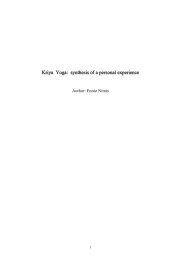Chapter 4
Chapter 4
Chapter 4
You also want an ePaper? Increase the reach of your titles
YUMPU automatically turns print PDFs into web optimized ePapers that Google loves.
Example 4.4: Non-Conducting Solid Sphere<br />
An electric charge + Q is uniformly distributed throughout a non-conducting solid sphere<br />
of radius a . Determine the electric field everywhere inside and outside the sphere.<br />
Solution:<br />
The charge distribution is spherically symmetric with the charge density given by<br />
Q Q<br />
ρ = =<br />
V (4/3) π a<br />
3<br />
(4.2.24)<br />
<br />
where V is<br />
the volume of the sphere. In this case, the electric field E is radially<br />
symmetric<br />
and directed outward. The magnitude of the electric field is constant on<br />
spherical surfaces of radius r . The regions r ≤ a and r ≥ ashall<br />
be studied separately.<br />
Case 1:<br />
r ≤ a.<br />
We choose our Gaussian surface to be a sphere of radius<br />
4.2.15(a).<br />
(a)<br />
r ≤ a,<br />
as shown in Figure<br />
Figure 4.2.15 Gaussian surface for uniformly charged solid sphere, for (a) r ≤ a,<br />
and (b)<br />
r > a.<br />
The flux through the Gaussian surface is<br />
Φ = E⋅ dA= EA= E π r<br />
<br />
2<br />
(4 )<br />
E<br />
∫∫<br />
With uniform charge distribution,<br />
the charge enclosed is<br />
S<br />
3<br />
⎛ ⎞<br />
⎛43⎞ r<br />
qenc = ∫ ρdV = ρV = ρ⎜ πr<br />
⎟=<br />
Q⎜ 3 ⎟ (4.2.25)<br />
3 a<br />
V<br />
⎝ ⎠ ⎝ ⎠<br />
(b)<br />
13

















